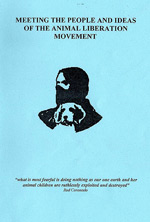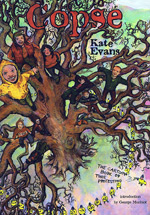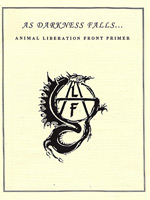» Next Entries
The Archives
-
One-off publications
Ecotage!
09.27.11 | PermalinkEcotage! (1971, New York, New York.)
For the last several months we have been pursuing some of our favorite activists and friends to write blogs introducing classics from our archives. As it turns out, our friends and favorite activists are lazy and regularly delinquent in transmitting promised writings. We still love them, even ol’ Ginger Rage, AKA Will Potter. He wrote the first of these guest editorials, and it was well worth the wait.
Rachel Carson’s Silent Spring is widely credited with igniting the modern environmental movement, which is true, but less well known is how quickly the movement radicalized.
By the first Earth Day in 1970, anonymous individuals were making headlines by targeting polluters. Illinois’s “The Fox” and Florida’s “Eco-Commando Force” developed a cult following. They were environmental vigilantes taking on the big, bad corporations, and people loved them.
By 1971, Environmental Action held a national contest soliciting tips on “ecotage.” The tips were compiled in a book and featured in national media.
The tone and honesty of Ecotage is refreshing and a bit surprising when read in the context of the current political climate. Reader-submitted ideas for tactics included re-painting billboards, pulling survey stakes, subscribing CEOs to hundreds of magazines, waging phone blockades, and sabotaging pollution-spewing pipes.
As described in the introduction: “…if ecotage is condemned, the condemnation is of a system which demands ecotage, a system which is so unresponsive to the needs and dreams of its constituents that it forces them underground to effect change.”
During the 1970s and 80s, this mainstreaming of animal and environmental concerns, combined with tiers of lawful and unlawful groups, was undeniably a threat to the corporations targeted. They needed to displace activists from their moral high ground.
A key development in orchestrating this fall from grace was the decision to wield the power of language. For those who break the law in the name of animal rights or the environment, industry groups would change the language from “ecotage” to “eco-terrorism.”
Ecotage should serve as a reminder that there is nothing inevitable about this. The FBI labels “eco-terrorism” the “number one domestic terrorism threat,” but public support is not, and has never been, with the corporations destroying the environment; it’s with those trying to stop them.

…
-
No Compromise, Periodicals
No Compromise #6-7
08.23.11 | PermalinkNo Compromise #6-7 (1997. Minneapolis, MN.)
The second year of No Compromise was packed with inspiring coverage of the growth of the militant grassroots, including some of the most important events of the 90s: Tony Wong’s hunger strike, the mass arrests and police riot at the Yerkes primate center, and the World Week for Animals in Laboratories arrests at the UC Davis primate center.
Tony Wong was only 16 years old when he was convicted for a civil disobedience action at the Lazurus department store. He immediately began a hungerstrike in prison, and after a month of not eating the staff at the juvenile facility where he was being held began force feeding him animal products through a tube forcefully inserted through his nose. The brutality faced by Tony acted as a lightning rod, and soon large demonstrations and acts of sabotage rippled across the country. The most important thing that Tony did though was to set an example of dedication that others could admire and aspire to in their own lives. Sadly, Tony eventually embraced a deeply speciesist political transformation and began consuming animals again after sacrificing so much to save them.
World Week in 1997 saw miniature police riots in Georgia and California. The protests themselves were not as important as the resulting boost to the movement created by the heavy handedness of the cops. As van loads of activists traveled to these demonstrations and found themselves sharing jail cells with like minded comrades, they soon formed tighter networks which led to greater revolutionary potential. The west coast and east coast both saw an upswing in regional actions after these arrests.
No Compromise was plagued by it’s usual production and distribution delays this year. It only got two issues finished, and they didn’t make it into people’s hands on the advertised cover dates, but both of these issues are wonderful documents of their era.
No Compromise #1-5 can be found here.
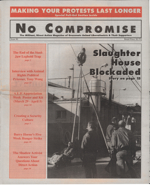
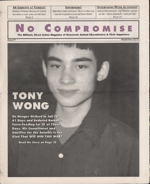
…
-
One-off publications
Interviews with ALF Activists
08.12.11 | PermalinkInterviews with ALF Activists (1986, England)
Following years of increasing direct actions in England, the British government began a full scale crackdown complete with round ups of people publishing pro-ALF literature. The SG Newsletter, once a radical mouthpiece for the underground, was targeted so often that it became mostly a prisoner support newsletter, at which point the government continued to attack it anyhow. Luckily, the ALF had clearly seen the Star Wars trilogy, because once the empire struck back it was time for the return of the vegan jedi!
Small incendiary devices, housed in cigarette boxes, were being used around the country to great effect in the fight against fur. The devices were not meant to cause actual fires, instead they were created to produce smoke which would set off department store fire sprinklers, thereby damaging merchandise with cascades of water. Some stores had faulty sprinkler systems, and a few burned completely to the ground. These attacks, though extreme and unpopular with the general public, basically spelled the end of fur in England. Not only did all major department store chains cease their trade in fur coats, they also stopped advertising it, which lowered overall demand. The arson campaign was a success, but with the SG out of commission, how would activists spread the methodology behind building these devices?
The answer was a network of grassroots, pro-direct action animal rights groups and their PO boxes. According to Kieth Mann, Interviews with Animal Liberation Front Activists had an initial print run of around 1,500 copies which were mailed to to the postal boxes of supportive groups. Inside were detailed instructions (which we have edited out due to federal laws pertaining to the dissemination of information to build destructive devices) on a number of fire bombs, as well as press clippings and interviews with the people behind much of the resistance taking place in England.
Careful readers will notice pages missing from our .PDF of “Interviews.” The reason for these missing pages is that after many years of photocopying the publication the final several pages, which contained addresses of laboratories, had become obsolete. In fact, many of them were out of date at the time of publication as they had been taken from documents issued by the Home Office in 1981, 5 years prior to the printing of this issue. As time went on these pages were omitted more and more frequently. We are looking for a complete copy of Interviews with Animal Liberation Front Activists, preferably one with sharper images and the old lab addresses. Please contact us at conflictgypsy (at) gmail (dot) com if you can provide us with one.

…
-
Most Popular, One-off publications
Earth First! Direct Action Manual 1st Edition
07.25.11 | PermalinkEarth First! Direct Action Manual 1st Edition (1997, Eugene, OR. USA)
As the militant environmental movement entered the mid 90’s it was mired in internal conflict about tactics, the relevance of other causes to wilderness defense, and whether or not violence was justifiable in solidarity with wild creatures and ecosystems. Despite this infighting groups like Earth First! managed to win some sizable campaigns using blockading and civil disobedience techniques.
As word spread about new tactics developing in the forests of Oregon and northern California, there was a sudden clamor from other activist groups to build their own lockboxes, barrels, tripods, and “black bears.” The DAM Collective answered this demand by printing the Earth First! Direct Action manual, a nicely illustrated and bound book containing how-to instructions on scouting, security, dealing with police, and setting up voluntary arrest scenarios utilizing “lock downs.”
But the Direct Action manual was more than that. It also contained short articles about Critical Mass, The Animal Liberation Front, varying theories on non-violence as an ethic vs. a tactical choice, and plenty of discussion of practical security measures for activists. It not only put the power of blockades into the hands of the masses, it also put minds into motion to consider the best ways forward for the radical environmental movement.
Conflict Gypsy has obtained a copy of the first edition of the Direct Action Manual (Commonly referred to at the time as the D.A.M.) for posting on the site, but would love to also post a copy of the second edition. Please contact us at conflictgypsy (at) gmail (dot) com if you can loan us one for scanning!
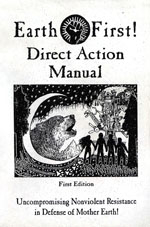
…
-
Periodicals, Underground
Underground #16
06.22.11 | PermalinkUnderground 16 (2001, Ontario, Canada)
Although the cover claims that this issue was released in Spring of 2000, in actuality, the final issue of Underground was so delayed that subscribers received it in the fall of 2001. By this time, the Stop Huntingdon Animal Cruelty campaign was in full swing, the world was seeing regular, large scale riots and street protests at political and industry events, and the Earth Liberation Front was moving the forefront of direct action in the United States. Underground had a number of redeeming features, not the least of which was its comprehensive, worldwide diary of actions, but its publication schedule, the release of Bite Back and the new SHAC newsletter, and the popularity of the internet as a source for news was chipping away at its relevance. It used its final issue to re-publish the Nighttime Gardener, cover the harassment of the ELF press office, and discuss news that was in many cases no longer new.
The magazine had quite a journey from its earlier incarnation as Combat and is clearly one of the most essential documents of the upswing in activity our movement witnessed in the 1990s. Bite Back magazine continues to fill the hole left by Underground’s disappearance, but us old timers will always remember these newsprint treasures with the kind of fondness that only comes from “being there.” It may sound funny, but I sometimes think of these old zines as fallen comrades. In that spirit, let me just say that death has a funny way of being impermanent in the world of activism. Here is to a new generation born from the ashes of those who Underground represented and reported on. Underground is dead, but the Underground lives on.
Also see Underground 1-3 and Underground 4-6 and Underground 7-9 and Underground 10-13 and Underground 14-15.
…
-
One-off publications
Meeting the People and Ideas of the Animal Liberation Movement
06.16.11 | PermalinkMeeting the People and Ideas of the Animal Liberation Movement (Publication date unknown, Amsterdam, Netherlands)
Before the age of “re-tweeting,” “re-blogging,” and “sharing” other people’s postings on the internet, zinester culture had its own form of helping spread information further afield from its initial distribution. DIY publishers would extract and reprint entire articles in their own zines which they had read first in other publications. In the case of this publication, activists in the Netherlands took some of the best articles from early issues of No Compromise and compiled them into this short, informative, and inspiring little booklet. Ideas which had previously been shared in the United States thus became available abroad, and the old information grapevine which relied on print was expanded just a little further. This is a good read with a mouthful of a title!
…
-
Periodicals, Underground
Underground #4-6
06.05.11 | PermalinkUnderground 4-6 (1996, Toronto, Ontario, Canada.)
As Underground magazine continued its run into 1996, the movement was once again in a state of internal dispute. The wave of FBI investigations and grand jury harassment earlier in the decade had put Rod Coronado behind bars. Sadly, an embarrassing moment in our history occurred when a small group of activists, including Rod’s long time friend and former housemate Jonathan Paul, called for support to be pulled from Rod. Their reasons were many, but largely centered around Rod’s desire to make the choices that effected his own defense. Jonathan and Rod later patched up their differences, but for many years those two great practitioners of direct action warred back and forth in the pages of this and other publications, which proved a waste of effort, time, and newsprint.
Luckily for nonhumans, 1996 was also a year that saw a tremendous upswing in resistance on their behalf. Notably, fur farm raids became common occurrences throughout the world. This was the year that saw the release of the infamous first edition of The Final Nail, a publication that gave addresses of fur farms and explained how to raid them. Excerpts appeared in Underground, and subscribers received free copies. Every issue throughout this period detailed the pressure being exerted on the fur farming industry, and proved that Rod’s imprisonment and the ensuing movement drama didn’t put the struggle for fur bearing animals in an early grave.
Underground also contained plenty of letters, news clippings, and short articles. Self criticism, analysis of movement building, targeting, press relations, and other strategic improvements are, sadly, largely absent. Still, the magazine provides one of the best glimpses into the way the ALF worked in North America in the 90s, which is why we will be posting every issue online, for free, by the middle of this month. Animal liberation history is for people, not profit!
Also see Underground 1-3 and Underground 7-9 and Underground 10-13 and Underground 14-15 and the final rare issue, Underground 16.
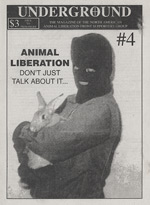
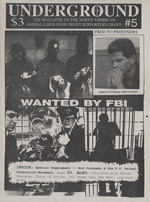

…
-
Books, Most Popular
Copse
05.29.11 | PermalinkCopse (1998, Kate Evans, Chippenham, England.)
“The direct action campaign against road building in Britain is the most successful revolutionary movement in Western Europe in the Second half of the 20th Century. Never before in this period have such radical aims been so comprehensively achieved in so short a time. Never before has a central component of government policy, to which billions of pounds had already been committed reversed, without the need of a change of government, by citizen politics. The humble, impoverished people who fought and won this war have plenty to be proud of.” -George Monbiot, from the introduction.
Sometimes a social ill can become so prevalent that it is sewn into the fabric of our society, normal in all senses, and so common that invisibility is reached. So it is with the car. Whether fueled by gasoline or electricity, bio-diesel or hydrogen, the automobile is one of the most destructive things on earth. Cars emit more than half the world’s air pollution, and kill more animals every year than the fur and vivisection industries combined. But that is only the beginning of the problem. You see, cars require roads, and they travel on them at deadly speeds. What this means is that the streets– a commons where people once gathered– are no longer a place to live and interact, but a place to pass through. The automobile has completely altered our social structure and harmed the ability of normal people to meet and share their discontent with the existing order. Roads now take up more than 1/3rd of most cities, and when parking, garages, gas stations, and other things necessary to feed and house cars are taken into consideration, more than half of our urban space is dedicated to traveling metal boxes. This is an ecological and social catastrophe that goes largely ignored even amongst those who care about human community, wilderness, and non-human animals.
But, it wasn’t always this way. Less than 20 years ago thousands of people fought against the building of new roads in England and elsewhere, and the actions which they undertook are greatly inspiring. From complex villages of tree sits and blockading devices to mass daylight arsons, the anti-roads movement was tremendously successful in preventing the furtherance of car culture and its corollary social and environmental impact.
There were many attempts at documenting this exciting people’s struggle, but none of them were quite as fun as Kate Evans’ Copse. Comprised of interviews, photographs, essays, and plenty of comics, Copse distilled the spirit of the protests onto each page. Part history lesson, part graphic novel, this book is a great starting place to understanding an important piece of the recent history of mass direct action.
…
-
One-off publications
On the Road
05.29.11 | PermalinkOn The Road (1995, North America)
Though it may now seem impossible, there was a time in our recent history when armed revolutionary groups operated inside North America with the intention of ending US imperialism. While many people may be aware of the Weather Underground and their symbolic bombings, fewer know of The George Jackson Brigade, the New World Liberation Front, the Armed Action Unit, Direct Action, the Black Liberation Army, or the United Freedom Front. These groups all occupied that chimerical realm known as “the underground.” On The Road described how these groups could somehow exist in plain sight while maintaining anonymity. While many of the tactics described herein are now obsolete, this short pamphlet provides us with a valuable peek at the creativity and discipline used to provide cover for hundreds of people at war with the United States and Canada.
It is also telling that there was a time when this pamphlet was widely distributed to animal rights and environmental militants. Starting at the end of the 1980s and continuing well into the present day, FBI surveillance and harassment of above ground activists reached levels intense enough to make many people consider whether or not they would be safer resisting omnicide from a more shadowy place.
…
-
One-off publications
As Darkness Falls
05.18.11 | PermalinkAs Darkness Falls (1995, USA.)
I remember thinking this was a pretty mediocre publication when I first saw it in the 90s, and it only took 3 sentences into my latest reading to remember why: If you are writing a primer and you think that Ed Abbey was the author of Eco-Defense, you’re likely not going to have much credibility with your intended audience. It doesn’t get a whole lot better as the zine progresses, and my impression is that this direct-action-how-to-for-beginners was, in fact, written by people with very little experience themselves carrying out actions. The advice is mostly taken from other sources, and what little original material is contained herein seems amateurish or even dangerous. For example, why would someone ever consider breaking windows with a pellet gun? They aren’t particularly effective, and you’ll also be committing a crime while carrying something that looks very much like a real firearm! As Darkness Falls is sprinkled with bad ideas and regurgitated information from other primers. It is presented here for the sake of the completeness of our archive as it is our goal to carry all widely distributed movement literature.
…
» Next Entries

